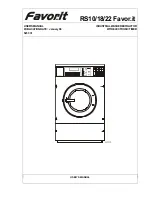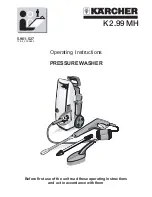
12
Maintenance
m
CAUTION!
Before working on the portable spray
washer, switch off the unit and remove the battery from the
compartment.
Bleeding the Air
During normal use, air may get trapped in the hose, which
will cause the pressure to drop. Bleeding the air before using
will allow air to escape and discharge residual pressure in the
hose.
1.
Make sure the water tank is filled with clean water.
2. With the water tank cap removed and spray gun pointing
into the water tank, squeeze the trigger and start the
machine (Fig. 13).
3.
Wait for a few seconds until the water flow is steady.
The unit is ready for use.
Storage
m
CAUTION!
Always store your cordless spray washer in
a location where the temperature will not fall below 32ºF (0ºC).
The pump in this machine is susceptible to permanent damage
if it freezes. FREEZE DAMAGE IS NOT COVERED BY THE
WARRANTY.
• Store the spray washer indoors in a dry, covered area
where it is not subject to adverse weather conditions.
•
It is important to store this product in a frost-free area.
•
Always empty water from all hoses, the pump, and the
water tank before storing.
m
CAUTION!
The use of a pump protector is
recommended to prevent cold weather damage during storage
over the winter months.
Winte long-term storage
If you must store your spray washer in a location where the
temperature falls below 32ºF (0ºC), you can minimize the
chance of damage to your machine by utilizing the following
procedure:
•
Turn on the machine for a few seconds until the remaining
water in the pump exits. Turn off immediately.
•
Do not allow the hose to become kinked.
•
Store the machine and accessories in a room that does
not reach freezing temperatures.
•
Do not store near a furnace or other sources of heat that
may dry out the pump seals.
• Operate the spray washer with non-corrosive/non-toxic
anti-freeze, a pump saver, or a pump protector before
storing for the winter.
m
WARNING!
Before reusing, completely flush the unit
out with clear water. Anti-freeze products can damage
paintwork, so you must ensure there is no anti-freeze left in the
system before using it again.
Disposal
Recycling the washer
•
Do not dispose of appliances as unsorted municipal
waste. Use separate collection facilities.
•
Contact your local government agency for information
regarding the collection systems available.
• If appliances are disposed of in landfills or dumps,
hazardous substances can leak into the groundwater and
get into the food chain, damaging your health and well-
being.
•
When replacing old appliances with new ones, the retailer
is legally obligated to take back your old appliance for
disposal at least free of charge.
Battery C Disposal
Always dispose of your battery pack according to federal,
state, and local regulations. Contact a recycling agency in your
area for recycling locations.
m
CAUTION!
Even discharged battery packs contain
some energy. Before disposing, use electrical tape to cover
the terminals to prevent the battery pack from shorting, which
could cause a fire or explosion.
m
WARNING!
To reduce the risk of injury or explosion,
never burn or incinerate a battery pack even if it is damaged,
dead or completely discharged. When burned, toxic fumes and
materials are emitted into the surrounding atmosphere.
Fig. 13
Summary of Contents for WA24C-LTE
Page 16: ...16 NOTES ...
Page 17: ...17 NOTES ...
Page 18: ...18 NOTES ...
Page 20: ...sunjoe com ...






































